The Cambridge History of China. Vol. 06. Alien Regimes and Border States, 907-1368
Подождите немного. Документ загружается.


BIBLIOGRAPHICAL ESSAYS
673
the physical remains
of
Liao.
The
field
was
developed
by
Japanese archaeologists,
beginning with
the
anthropologist-archaeologist Torii Ryuzo (1870-1953).
His
series
of
articles
in the
early 1930s, "Ryodai
no
hekiga
ni
tsuite,"
64
in
Kokka,
introduced
the
startling wall paintings discovered
in the
royal tombs. They were
followed
by the
publication
of his
Kokogaku
jo
yori mitaru
Ryo no
bunka,
6
* which
presents
a
large collection
of
plates;
the
text seems never
to
have been published.
See
also
his
Ryo no bunka wo saguru.
66
On the
early Japanese excavations, see also Tamura
Jitsuzo
and
Kobayashi Yukio's study
of the
Ch'ing-ling,
the
mausoleum
of
Sheng-
tsung,
67
and
Shimada Masao's report
on the
site
of
Tsu-chou.
68
An
interesting
and
more up-to-date account
of
the Ch'ing-ling tomb
and its
paintings
is
that
by
Tamura
Jitsuzo,
Keiryo no
hekiga.
69
Since
the
1950s other tombs containing paintings
and a
wide variety
of
artifacts
have been discovered
by
Chinese archaeologists. Three Western studies imaginatively
used this material
to
illustrate aspects
of
Khitan life: Ellen Johnston Laing, "Patterns
and problems
in
later Chinese tomb decoration";
70
Linda Cooke Johnson,
"The
wedding ceremony
for an
imperial Liao princess: Wall paintings from
a
Liao dynasty
tomb
in
Jilin";
71
and
Albright Rorex, "Some Liao tomb murals
and
images
of
nomads
in
Chinese paintings
of
the Wen-chi story."
72
On Liao ceramics
and
kiln sites,
see
William Watson,
T'ang
and
Liao
ceramics,™
and
Lin
Wen-hsin
and Chu
Tzu-tang's descriptive work
on
Liao ceramics
in the
Liao-
ning Provincial Museum.
74
See also
the
exhibition catalogue
by
Mino Yutaka, Ceram-
ics
in
the
Liao dynasty, published
in
1973, which includes
an
excellent bibliography
to
that date.
7
'
One field
in
which
the
Liao produced unquestioned masterpieces was architecture.
Over thirty major buildings, constructed
of
both stone
and
timber, survive, some
incorporating important technical innovations.
The
classic descriptive work
on
Liao
and Chin architecture
is the
collection
of
fine photographs published
by
Sekino
Tadashi
and
Takejima Takuichi
in 1934 and the
accompanying study
by
Takejima
that appeared
ten
years later.
76
The
most beautiful
of all
Liao buildings,
the
great
wooden pagoda
at
Ying-hsien
in
northeastern Shansi,
is the
subject
of
a monograph
64 Torii Ryuzo, "Ryddai no hekiga ni tsuite,"
Kokka
490, pp. 272-80; 491, pp. 283-9; 492, pp. 313—
I7M93.
PP- 343-5° ('930.
65
Torii Ryuzo,
Kokogaku
jo
yori mitaru Ryo
no
bunka: Zufu,
4
vols. (Tokyo, 1936).
66 Torii Ryuzo, Ryo
no
bunka wo saguru (Tokyo, 1937).
67 Tamura Jitsuzo
and
Kobayashi Yukio, Keiryo (Kyoto, 1953).
68 Shimada Masao,
So-sbu
jo
(Tokyo, 19;;).
69 Tamura Jitsuzo, Keiryo no hekiga (Kyoto, 1977).
70 Ellen Johnston Laing, "Patterns
and
problems
in
later Chinese tomb decoration," Journal
of
Oriental
Studies, 16(1978),
pp.
3—20.
71 Linda Cooke Johnson,
"The
wedding ceremony
for an
imperial Liao princess: Wall paintings from
a
Liao dynasty tomb
in
Jilin," Artibus Asiae,
44
(1983),
pp.
107—36.
72 Albright Rorex, "Some Liao tomb murals
and
images
of
nomads
in
Chinese paintings
of
the Wen-chi
story," Artibus Asiae,
45
(1984),
pp.
174—98.
73 William Watson,
T'ang
and
Liao
ceramics
(New
York, 1984).
74
Li
Wen-hsin
and Chu
Tzu-fang, Liao-ning
sheng
po-wu-yiian tsang Liao
tz'u
hsiian-chi
(Peking, 1961).
75 Mino Yutaka,
Ceramics
in
the Liao dynasty: North and
south
of
the
Great Wall (New York, 1973).
76
See
Sekino Tadashi
and
Takejima Takuichi, Ryo Kin jidai no
kenchiku
to
sono
Butsuzo,
2
vols.
of
plates
(Tokyo, 1934);
and
Takejima Takuichi, Ryo Kin jidai
no kenchiku
to
sono
Butsuzo (Tokyo, 1944).
Cambridge Histories Online © Cambridge University Press, 2008
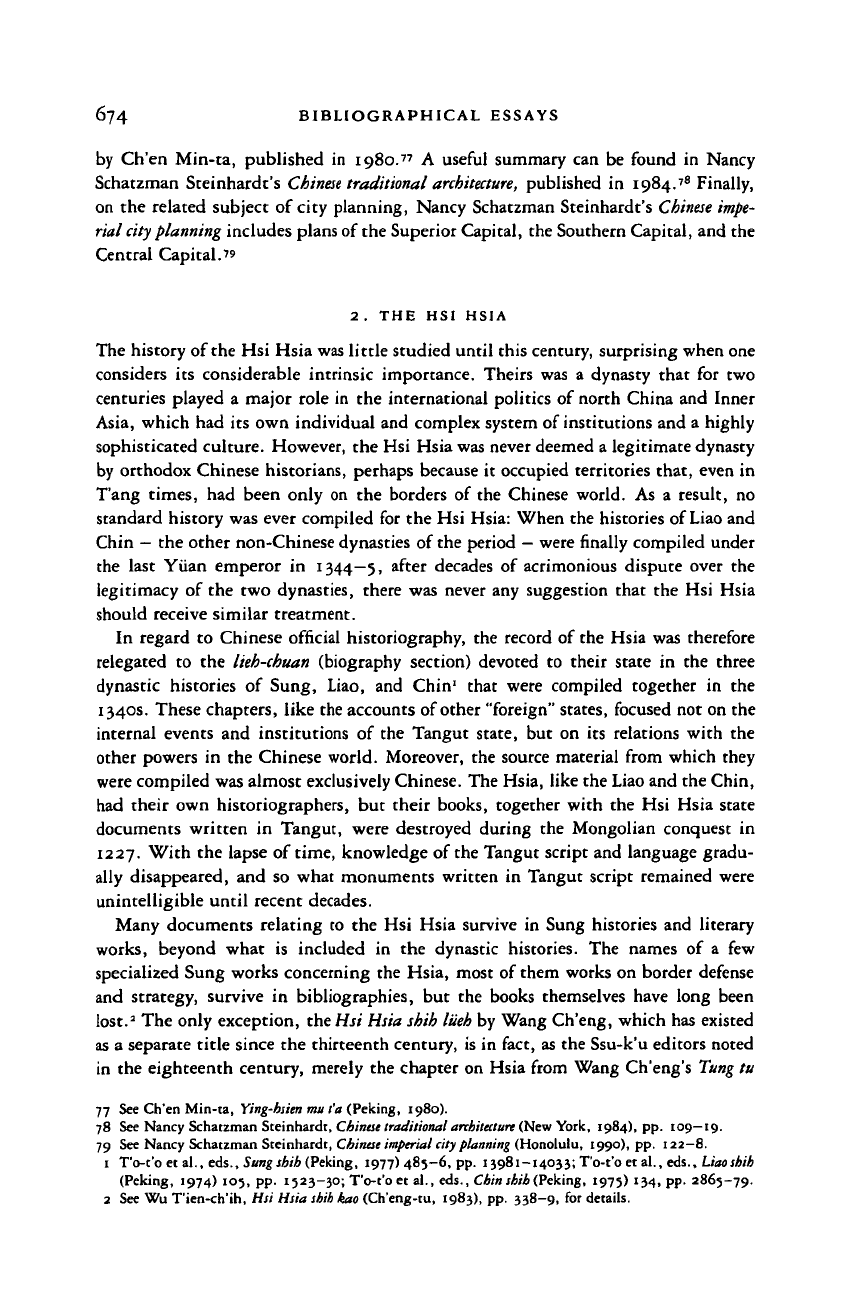
674 BIBLIOGRAPHICAL ESSAYS
by Ch'en Min-ta, published in 1980.
77
A useful summary can be found in Nancy
Schatzman Steinhardc's
Chinese traditional
architecture,
published in 1984.
78
Finally,
on the related subject of city planning, Nancy Schatzman Steinhardt's
Chinese
impe-
rial city planning
includes plans of the Superior Capital, the Southern Capital, and the
Central Capital."
2 . THE HSI HSIA
The history of the Hsi Hsia was little studied until this century, surprising when one
considers its considerable intrinsic importance. Theirs was a dynasty that for two
centuries played a major role in the international politics of north China and Inner
Asia, which had its own individual and complex system of institutions and a highly
sophisticated culture. However, the Hsi Hsia was never deemed a legitimate dynasty
by orthodox Chinese historians, perhaps because it occupied territories that, even in
T'ang times, had been only on the borders of the Chinese world. As a result, no
standard history was ever compiled for the Hsi Hsia: When the histories of
Liao
and
Chin
—
the other non-Chinese dynasties of the period
—
were finally compiled under
the last Yiian emperor in 1344—5,
ar
*
er
decades of acrimonious dispute over the
legitimacy of the two dynasties, there was never any suggestion that the Hsi Hsia
should receive similar treatment.
In regard to Chinese official historiography, the record of the Hsia was therefore
relegated to the
lieh-chuan
(biography section) devoted to their state in the three
dynastic histories of Sung, Liao, and Chin" that were compiled together in the
1340s. These chapters, like the accounts of other "foreign" states, focused not on the
internal events and institutions of the Tangut state, but on its relations with the
other powers in the Chinese world. Moreover, the source material from which they
were compiled was almost exclusively Chinese. The Hsia, like the Liao and the Chin,
had their own historiographers, but their books, together with the Hsi Hsia state
documents written in Tangut, were destroyed during the Mongolian conquest in
1227.
With the lapse of time, knowledge of the Tangut script and language gradu-
ally disappeared, and so what monuments written in Tangut script remained were
unintelligible until recent decades.
Many documents relating to the Hsi Hsia survive in Sung histories and literary
works, beyond what is included in the dynastic histories. The names of a few
specialized Sung works concerning the Hsia, most of them works on border defense
and strategy, survive in bibliographies, but the books themselves have long been
lost.
1
The only exception, the Hsi
Hsia shih liieh
by Wang Ch'eng, which has existed
as a separate title since the thirteenth century, is in fact, as the Ssu-k'u editors noted
in the eighteenth century, merely the chapter on Hsia from Wang Ch'eng's
Tung
tu
77 See Ch'en Min-ta, Yittg-hsien ma t'a (Peking, 1980).
78 See Nancy Schatzman Steinhardt,
Chinese
traditional
architecture
(New York, 1984), pp. 109—19.
79 See Nancy Schatzman Steinhardt,
Chinese
imperial city planning (Honolulu, 1990), pp. 122—8.
1 T'o-t'o et al., eds., Sung shih (Peking, 1977) 485—6, pp. 13981—14033; T'o-t'oet al., eds., Liao shih
(Peking, 1974) 105, pp. 1523-30; T'o-t'o et al., eds., Chin ihih(Peking, 1975) 134, pp. 2865-79.
2 See Wu T'ien-ch'ih, Hsi Hsia
shih
kao (Ch'eng-tu, 1983), pp. 338-9, for details.
Cambridge Histories Online © Cambridge University Press, 2008

BIBLIOGRAPHICAL ESSAYS
675
shih
liieh
(of
1186) published
as a
separate book
and
given
a new
title
by a
later
publisher.
3
Attempts
to
synthesize
a
history
of
the Hsia from
all
surviving Chinese sources
began
in the
eighteenth century. Among
the
scholars who wrote
on the
Hsia were
Hung Liang-chi, whose Hsi Hsia kuo
chih
was never completed,
and
Ch'in En-fu,
whose Hsi
Hsia shu
was destroyed soon after
its
completion. Two major nineteenth-
century works were printed
and
still survive:
Wu
Kuang-ch'eng's chronological
history Hsi Hsia
sbu shih
in
forty-two chapters, completed
in
1825—7,
an
d
Chang
Chien's topical history, Hsi Hsia
chi shih pen mo
in
thirty-six chapters, completed
in
1884.
Both remain important
to
modern historians. Most
of
the source material
for
the Hsi
Hsia chi shih pen mo
can readily be identified in other works. The Hsi
Hsia shu
shih,
on the other hand, contains
a
great deal of important information that cannot be
found elsewhere. However, because
the
provenance
of
much
of
Wu Kuang-ch'eng's
material
is
unclear and sometimes dubious, his book, valuable as
it is,
needs
to be
used with caution.
The most recent attempt
at
this type of traditional historical synthesis was the Hsi
Hsia chi
completed by Tai Hsi-chang
in
1927. Unlike his predecessors, the author of
this carefully compiled work identifies his sources and lists the works he consulted.
The only major Sung source that he did not use is the
Sung
huiyao,
which was not yet
published
in
his time.
A short but still useful study of these early histories was published
in
1943 by the
prolific scholar of Chinese historiography Chu Hsi-tsu.
4
Discovery ofTangut documents and the decipherment of the language
Sometime before Tai Hsi-chang's work was published, the study of the Tanguts and
the
Hsi
Hsia was greatly advanced with
the
discovery
of a
great body
of
original
documentation
in
the Hsi Hsia language and script. Some Hsi Hsia documents were
found by Sir Aurel Stein and Paul Pelliot at Tun-huang.
In
1908 and 1909 a Russian
expedition led by Major
P.
K.
Kozlov discovered and excavated the remains of
a
Hsi
Hsia city
at
Edzina (Khara-Khoto). Among their discoveries was the tomb of
a
noble
Buddhist lady containing thousands
of
books
and
documents, both printed
and
manuscript.
The
same area
was
later investigated
by Sir
Aurel Stein, Langdon
Warner, and the expedition
led
by Sven Hedin, and although their discoveries were
not
on
such
a
grand scale
as
Kozlov's, more documents came
to
light. Still other
documents were discovered
by
Chinese archaeologists
in
recent decades. This
new
documentation, although
it
could
not yet be
deciphered, provided
a
large body
of
historical evidence from
the
Tangut themselves,
not
from their Chinese neighbors.
Some tentative studies about
the
Tangut language
had
already been published
before these discoveries, based
on a
few bilingual stone inscriptions, notably
by M.
G. Deveria at the very end of the nineteenth century, but to all intents and purposes
the language was still unreadable.
The
serious study
of
the Tangut language
was
3 See Chi Yiin
et
al., comps., Ssu k'u
ch'iian
shu tsung mu t'iyao,
66, p. 1443.
4 Chu Hsi-tsu, "Hsi Hsia shih
chi
k'ao,"
in
Shuo wen
yiieb k'an,
3
(1943),
pp.
25-30.
Cambridge Histories Online © Cambridge University Press, 2008
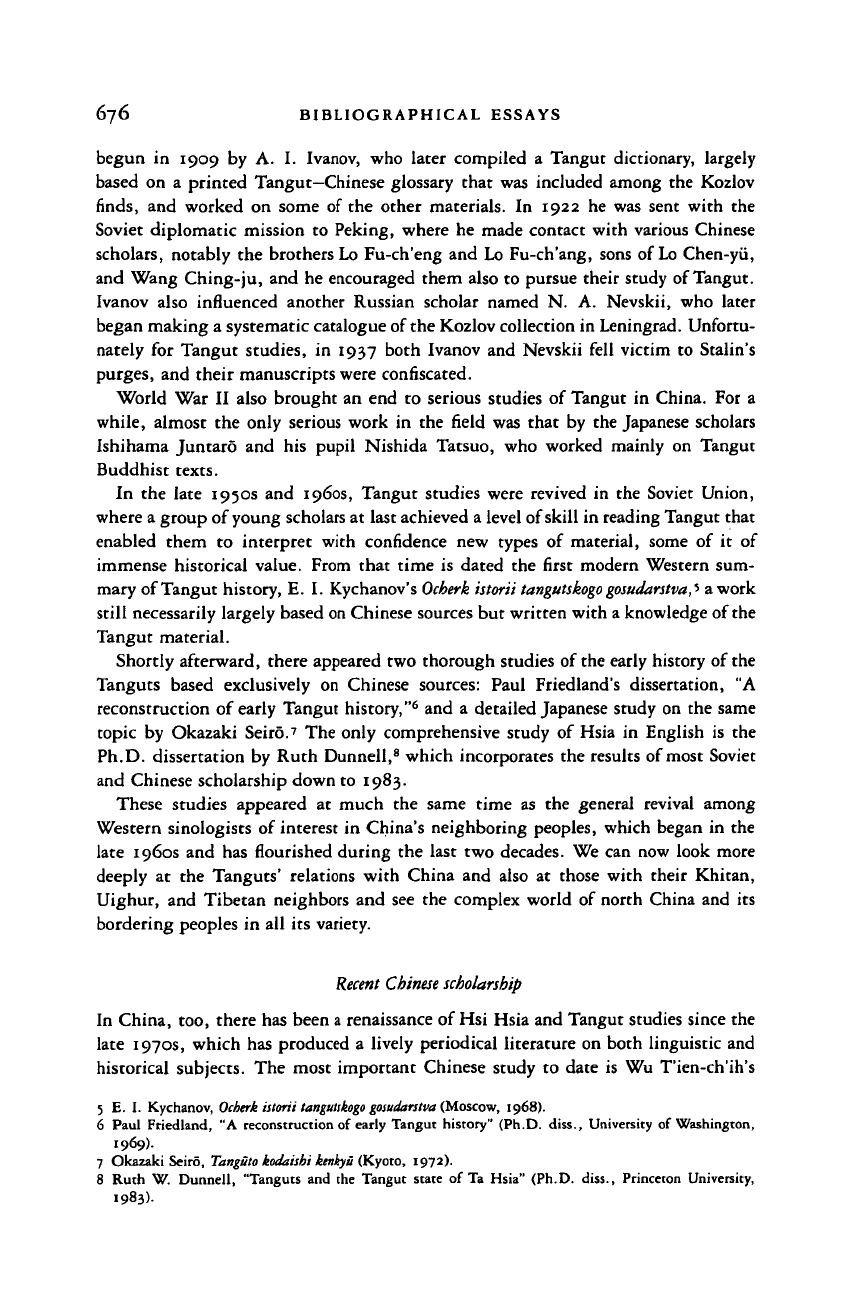
676 BIBLIOGRAPHICAL ESSAYS
begun in 1909 by A. I. Ivanov, who later compiled a Tangut dictionary, largely
based on a printed Tangut—Chinese glossary that was included among the Kozlov
finds,
and worked on some of the other materials. In 1922 he was sent with the
Soviet diplomatic mission to Peking, where he made contact with various Chinese
scholars, notably the brothers Lo Fu-ch'eng and Lo Fu-ch'ang, sons of
Lo
Chen-yii,
and Wang Ching-ju, and he encouraged them also to pursue their study of Tangut.
Ivanov also influenced another Russian scholar named N. A. Nevskii, who later
began making a systematic catalogue of the Kozlov collection in Leningrad. Unfortu-
nately for Tangut studies, in 1937 both Ivanov and Nevskii fell victim to Stalin's
purges, and their manuscripts were confiscated.
World War II also brought an end to serious studies of Tangut in China. For a
while, almost the only serious work in the field was that by the Japanese scholars
Ishihama Juntaro and his pupil Nishida Tatsuo, who worked mainly on Tangut
Buddhist texts.
In the late 1950s and 1960s, Tangut studies were revived in the Soviet Union,
where a group of young scholars at last achieved a level of skill in reading Tangut that
enabled them to interpret with confidence new types of material, some of it of
immense historical value. From that time is dated the first modern Western sum-
mary of Tangut history, E. I. Kychanov's
Ocherk istorii tangutskogo
gosudarstva,*
a
work
still necessarily largely based on Chinese sources but written with a knowledge of the
Tangut material.
Shortly afterward, there appeared two thorough studies of the early history of the
Tanguts based exclusively on Chinese sources: Paul Friedland's dissertation, "A
reconstruction of early Tangut history,"
6
and a detailed Japanese study on the same
topic by Okazaki Seiro.
7
The only comprehensive study of Hsia in English is the
Ph.D.
dissertation by Ruth Dunnell,
8
which incorporates the results of most Soviet
and Chinese scholarship down to 1983.
These studies appeared at much the same time as the general revival among
Western sinologists of interest in China's neighboring peoples, which began in the
late 1960s and has flourished during the last two decades. We can now look more
deeply at the Tanguts' relations with China and also at those with their Khitan,
Uighur, and Tibetan neighbors and see the complex world of north China and its
bordering peoples in all its variety.
Recent Chinese scholarship
In China, too, there has been
a
renaissance of Hsi Hsia and Tangut studies since the
late 1970s, which has produced a lively periodical literature on both linguistic and
historical subjects. The most important Chinese study to date is Wu T'ien-ch'ih's
5 E. I. Kychanov,
Ocherk
istorii
tangutikogo gosudarstoa
(Moscow, 1968).
6 Paul Fried land, "A reconstruction of early Tangut history" (Ph.D. diss., University of Washington,
1969)-
7 Okazaki Seiro, Tanguto kodaishi
kenkyu
(Kyoto, 1972).
8 Ruth W. Dunnell, "Tanguts and the Tangut state of Ta Hsia" (Ph.D. diss., Princeton University,
1983).
Cambridge Histories Online © Cambridge University Press, 2008
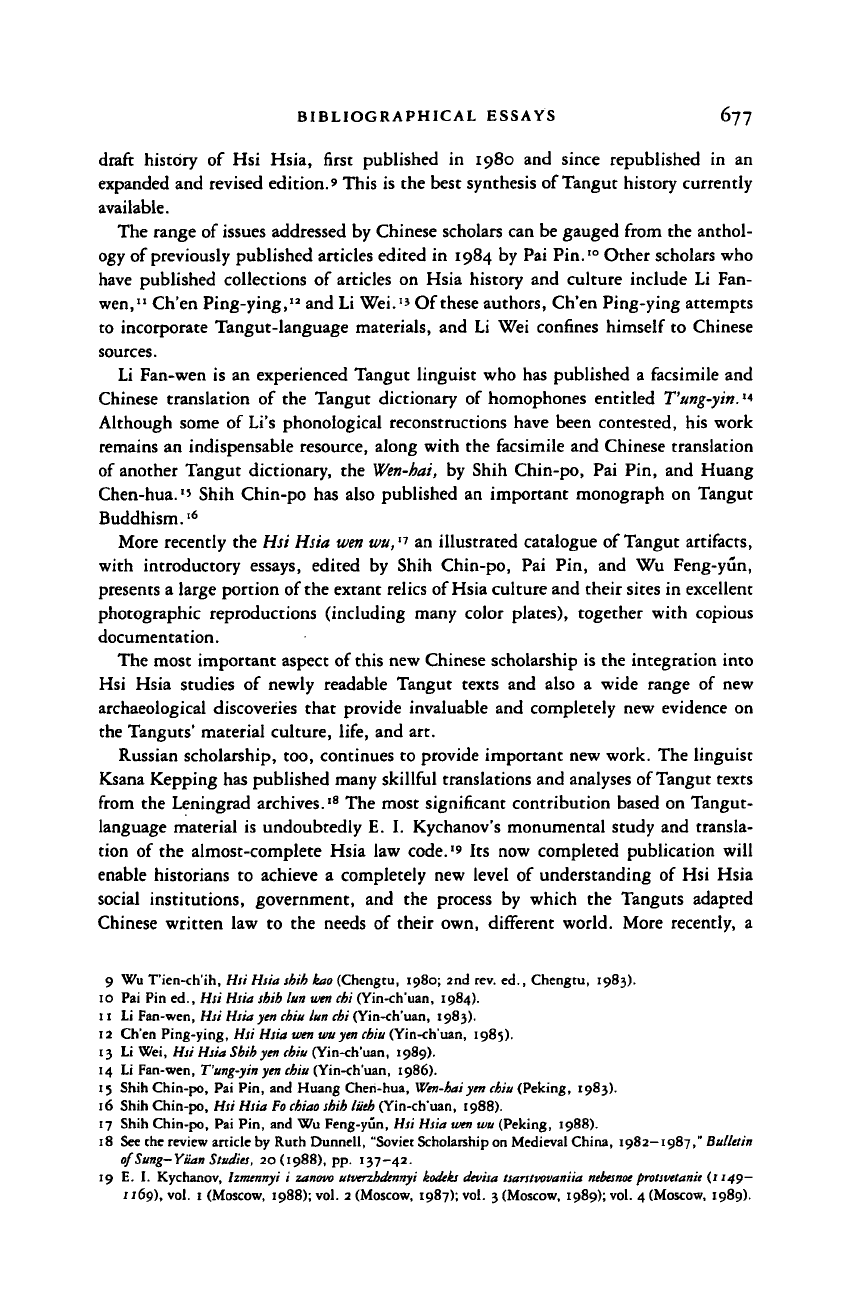
BIBLIOGRAPHICAL ESSAYS 677
draft history of Hsi Hsia, first published in 1980 and since republished in an
expanded and revised edition.
9
This is the best synthesis of Tangut history currently
available.
The range of issues addressed by Chinese scholars can be gauged from the anthol-
ogy of previously published articles edited in 1984 by Pai Pin.'° Other scholars who
have published collections of articles on Hsia history and culture include Li Fan-
wen," Ch'en Ping-ying,
12
and Li Wei.
1
' Of
these
authors, Ch'en Ping-ying attempts
to incorporate Tangut-language materials, and Li Wei confines himself to Chinese
sources.
Li Fan-wen is an experienced Tangut linguist who has published a facsimile and
Chinese translation of the Tangut dictionary of homophones entitled T'ung-yin.'«
Although some of Li's phonological reconstructions have been contested, his work
remains an indispensable resource, along with the facsimile and Chinese translation
of another Tangut dictionary, the
Wen-hat,
by Shih Chin-po, Pai Pin, and Huang
Chen-hua.
15
Shih Chin-po has also published an important monograph on Tangut
Buddhism.'
6
More recently the Hsi
Hsia wen
wu,
11
an illustrated catalogue of Tangut artifacts,
with introductory essays, edited by Shih Chin-po, Pai Pin, and Wu Feng-yun,
presents a large portion of
the
extant relics of
Hsia
culture and their sites in excellent
photographic reproductions (including many color plates), together with copious
documentation.
The most important aspect of this new Chinese scholarship is the integration into
Hsi Hsia studies of newly readable Tangut texts and also a wide range of new
archaeological discoveries that provide invaluable and completely new evidence on
the Tanguts' material culture, life, and art.
Russian scholarship, too, continues to provide important new work. The linguist
Ksana Kepping has published many skillful translations and analyses of Tangut texts
from the Leningrad archives.'
8
The most significant contribution based on Tangut-
language material is undoubtedly E. I. Kychanov's monumental study and transla-
tion of the almost-complete Hsia law
code.
•' Its now completed publication will
enable historians to achieve a completely new level of understanding of Hsi Hsia
social institutions, government, and the process by which the Tanguts adapted
Chinese written law to the needs of their own, different world. More recently, a
9 Wu T'ien-ch'ih, Hsi Hsia sbih kao (Chengtu, 1980; 2nd rev. ed., Chengtu, 1983).
10 Pai Pin ed., Hsi Hsia shih lun wen chi (Yin-ch'uan, 1984).
11 Li Fan-wen, Hsi Hsia yen chiu lun chi (Yin-ch'uan, 1983).
12 Ch'en Ping-ying, Hsi Hsia wen wu
yen chiu
(Yin-ch'uan, 1985).
13 Li Wei, Hsi Hsia Shih yen chiu (Yin-ch'uan, 1989).
14 Li Fan-wen, T'ung-yin yen chiu (Yin-ch'uan, 1986).
15 Shih Chin-po, Pai Pin, and Huang Cheri-hua,
Wen-hai yen
chiu (Peking, 1983).
16 Shih Chin-po, Hsi Hsia
Fo chiao
shih
liieh
(Yin-ch'uan, 1988).
17 Shih Chin-po, Pai Pin, and Wu Feng-yun, Hsi Hsia wen wu (Peking, 1988).
18 See the review article by Ruth Dunnell, "Soviet Scholarship on Medieval China, 1982-1987," Bulletin
of
Sung—Yuan
Studies, 20(1988), pp. 137—42.
19 E. I. Kychanov, Hmennyi i zanwo utverzhdennyi
koaeks
devisa tsarstvovaniia
mbesnoe protsvetanie
(1149-
1169), vol. 1 (Moscow, 1988); vol. 2 (Moscow, 1987); vol. 3 (Moscow, 1989); vol. 4 (Moscow, 1989).
Cambridge Histories Online © Cambridge University Press, 2008
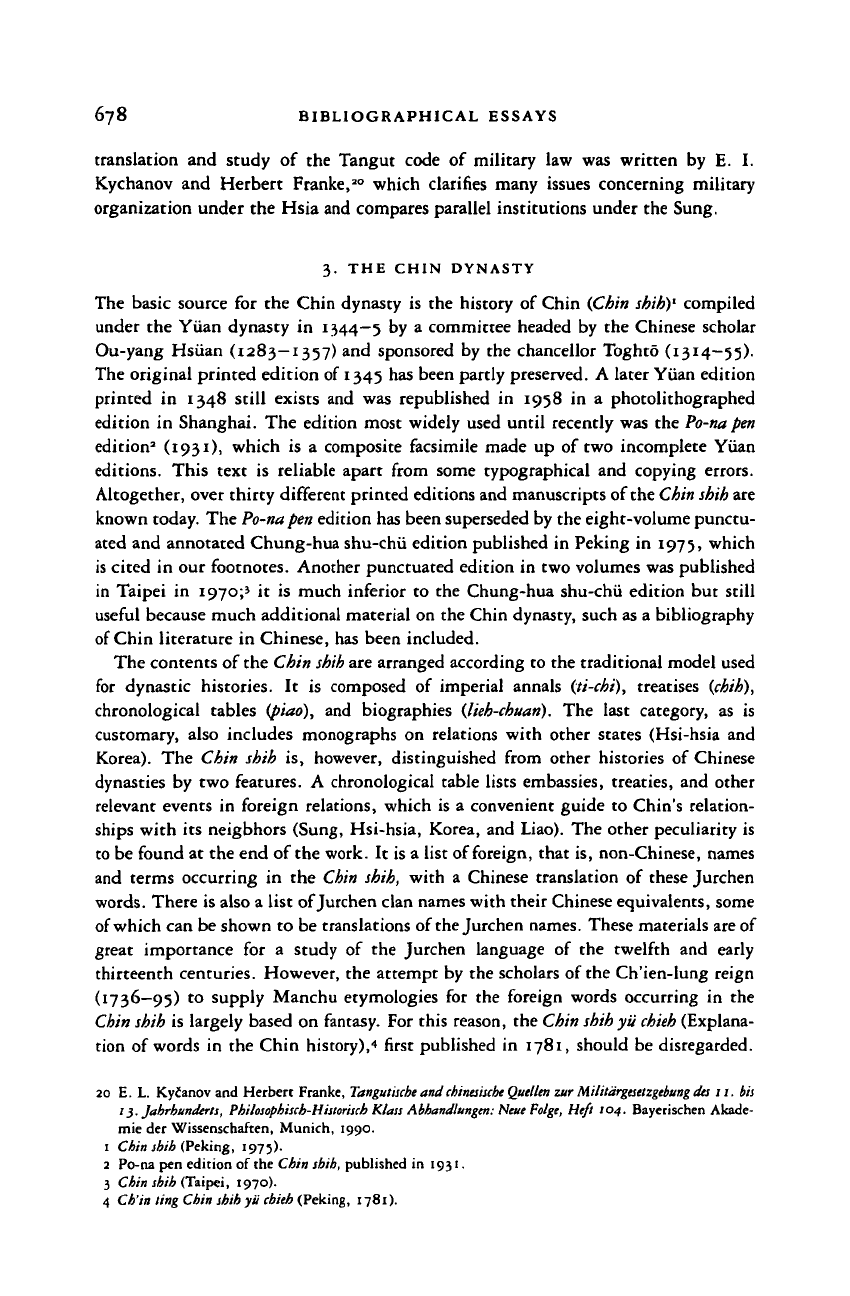
678 BIBLIOGRAPHICAL ESSAYS
translation
and
study
of
the Tangut code
of
military
law
was written
by E. I.
Kychanov and Herbert Franke,
20
which clarifies many issues concerning military
organization under the Hsia and compares parallel institutions under the Sung.
3.
THE CHIN DYNASTY
The basic source for the Chin dynasty
is
the history of Chin
(Chin
shih)
1
compiled
under the Yuan dynasty
in
1344—5 by
a
committee headed by the Chinese scholar
Ou-yang Hsiian (1283—1357) and sponsored by the chancellor Toghto (1314-55).
The original printed edition of 1345 has been partly preserved. A later Yuan edition
printed
in
1348 still exists and was republished
in
1958
in a
photolithographed
edition
in
Shanghai. The edition most widely used until recently was the
Po-na pen
edition
2
(1931), which
is a
composite facsimile made up of two incomplete Yuan
editions. This text
is
reliable apart from some typographical and copying errors.
Altogether, over thirty different printed editions and manuscripts of
the Chin shih
are
known today. The
Po-na pen
edition has been superseded by the eight-volume punctu-
ated and annotated Chung-hua shu-chii edition published in Peking in 1975, which
is cited in our footnotes. Another punctuated edition in two volumes was published
in Taipei
in
1970;
3
it is
much inferior
to
the Chung-hua shu-chii edition but still
useful because much additional material on the Chin dynasty, such as a bibliography
of Chin literature in Chinese, has been included.
The contents of the Chin
shih
are arranged according to the traditional model used
for dynastic histories.
It is
composed
of
imperial annals (ti-chi), treatises (chih),
chronological tables (piao),
and
biographies
(lieh-chuan).
The last category,
as is
customary, also includes monographs
on
relations with other states (Hsi-hsia and
Korea). The Chin shih
is,
however, distinguished from other histories
of
Chinese
dynasties by two features. A chronological table lists embassies, treaties, and other
relevant events
in
foreign relations, which is
a
convenient guide to Chin's relation-
ships with its neigbhors (Sung, Hsi-hsia, Korea, and Liao). The other peculiarity is
to be found at the end of the work.
It
is a list of foreign, that is, non-Chinese, names
and terms occurring
in
the
Chin
shih, with
a
Chinese translation
of
these Jurchen
words. There is also a list of Jurchen clan names with their Chinese equivalents, some
of which can be shown to be translations of
the
Jurchen names. These materials are of
great importance
for a
study
of
the Jurchen language
of
the twelfth
and
early
thirteenth centuries. However, the attempt by the scholars of the Ch'ien-lung reign
(1736—95)
to
supply Manchu etymologies
for
the foreign words occurring
in
the
Chin shih
is largely based on fantasy. For this reason, the
Chin shih
yii
chieh
(Explana-
tion of words
in
the Chin history),
4
first published
in
1781, should be disregarded.
20
E. L.
Kyianovand Herbert Franke, Tangutischeandchinaische Quellen
zur
Militdrgaetzgebung des
11. bis
i}.Jahrhundtrts, Philosophisch-Wstorisch Klass Abhandlungtn: Neue Folge, Heft
104.
Bayerischen Akade-
mie der Wissenschaften, Munich, 1990.
1 Chin shih (Peking, 1975)-
2 Po-na pen edition
of
the Chin shih, published
in
1931.
3 Chin shih (Taipei, 1970).
4 Ch'in ling Chin shih yii
chieh
(Peking, 1781).
Cambridge Histories Online © Cambridge University Press, 2008
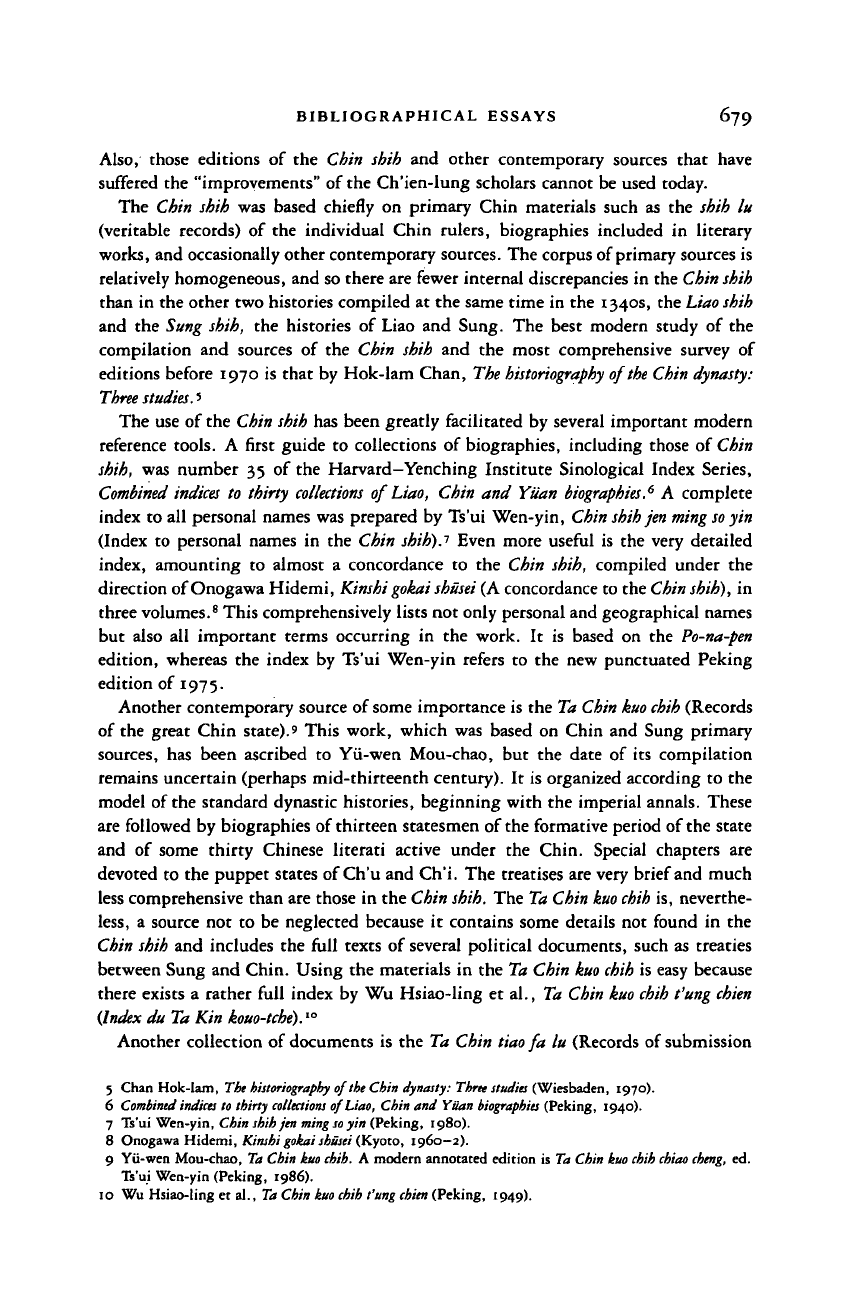
BIBLIOGRAPHICAL ESSAYS 679
Also,
those editions of the Chin shih and other contemporary sources that have
suffered the "improvements" of the Ch'ien-lung scholars cannot be used today.
The Chin shih was based chiefly on primary Chin materials such as the shih lu
(veritable records) of the individual Chin rulers, biographies included in literary
works, and occasionally other contemporary sources. The corpus of primary sources is
relatively homogeneous, and so there are fewer internal discrepancies in the
Chin shih
than in the other two histories compiled at the same time in the 1340s, the
Liao shih
and the
Sung
shih, the histories of Liao and Sung. The best modern study of the
compilation and sources of the Chin shih and the most comprehensive survey of
editions before 1970 is that by Hok-lam Chan,
The historiography
of
the Chin
dynasty:
Three
studies.'
The use of the
Chin shih
has been greatly facilitated by several important modern
reference tools. A first guide to collections of biographies, including those of
Chin
shih,
was number 35 of the Harvard-Yenching Institute Sinological Index Series,
Combined indices
to thirty
collections
of Liao, Chin and Yiian
biographies.
6
A complete
index to all personal names was prepared by Ts'ui Wen-yin,
Chin shih jen ming so
yin
(Index to personal names in the Chin shih).
1
Even more useful is the very detailed
index, amounting to almost a concordance to the Chin shih, compiled under the
direction of Onogawa Hidemi,
Kinshi gokai shusei
(A concordance to the
Chin
shih),
in
three volumes.
8
This comprehensively lists not only personal and geographical names
but also all important terms occurring in the work. It is based on the
Po-na-pen
edition, whereas the index by Ts'ui Wen-yin refers to the new punctuated Peking
edition of 1975.
Another contemporary source of
some
importance is the
Ta Chin kuo chih
(Records
of the great Chin state).
9
This work, which was based on Chin and Sung primary
sources, has been ascribed to Yii-wen Mou-chao, but the date of its compilation
remains uncertain (perhaps mid-thirteenth century). It is organized according to the
model of the standard dynastic histories, beginning with the imperial annals. These
are followed by biographies of thirteen statesmen of the formative period of the state
and of some thirty Chinese literati active under the Chin. Special chapters are
devoted to the puppet states of Ch'u and Ch'i. The treatises are very brief
and
much
less comprehensive than are those in the
Chin
shih.
The
Ta Chin kuo chih
is, neverthe-
less,
a source not to be neglected because it contains some details not found in the
Chin shih
and includes the full texts of several political documents, such as treaties
between Sung and Chin. Using the materials in the Ta
Chin kuo chih
is easy because
there exists a rather full index by Wu Hsiao-ling et al., Ta
Chin kuo chih
t'ung
chien
(Index du Ta Kin
kouo-tche).
IO
Another collection of documents is the Ta Chin
tiao
fa lu (Records of submission
5 Chan Hok-lam, The
historiography
of the Chin dynasty: Thru studio (Wiesbaden, 1970).
6
Combined indices
to thirty
collections
of
Liao,
Chin and Yuan
biographies
(Peking, 1940).
7 Ts'ui Wen-yin, Chin
shih
jen
ming so
yin (Peking, 1980).
8 Onogawa Hidemi, Kinshi gokai
shusei
(Kyoto, 1960-2).
9 Yii-wen Mou-chao, Ta Chin kuo chih. A modern annotated edition is Ta Chin kuo
chih chiao
cheng,
ed.
Ts'ui Wen-yin (Peking, 1986).
10 Wu Hsiao-ling et al., Ta Chin kuo chih t'ung
chien
(Peking, 1949).
Cambridge Histories Online © Cambridge University Press, 2008
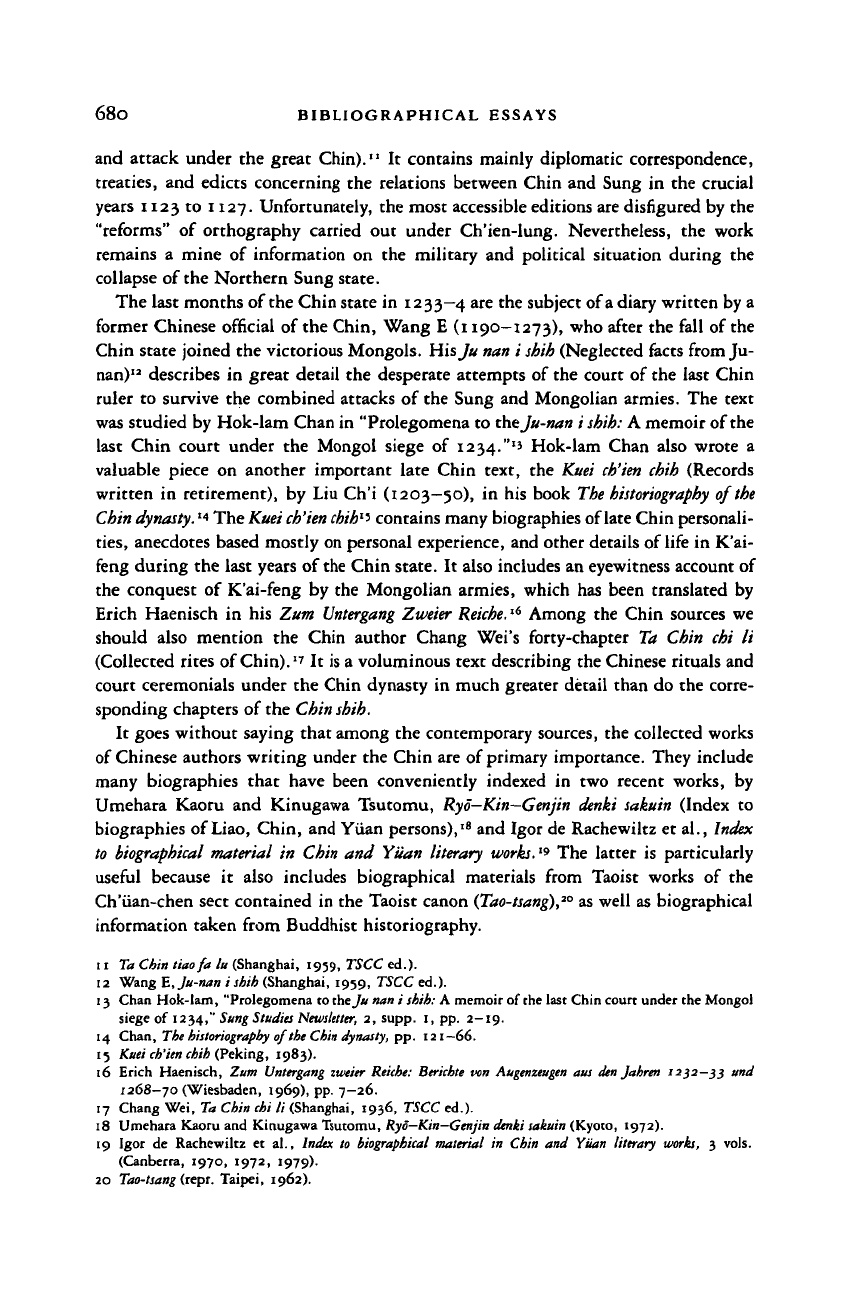
680 BIBLIOGRAPHICAL ESSAYS
and attack under the great Chin)." It contains mainly diplomatic correspondence,
treaties, and edicts concerning the relations between Chin and Sung in the crucial
years 1123 to 1127. Unfortunately, the most accessible editions are disfigured by the
"reforms" of orthography carried out under Ch'ien-lung. Nevertheless, the work
remains a mine of information on the military and political situation during the
collapse of the Northern Sung state.
The last months of
the
Chin state in 1233—4
are tne
subject of
a
diary written by a
former Chinese official of the Chin, Wang E (1190-1273), who after the fall of the
Chin state joined the victorious Mongols. His Ju
nan
i
shih
(Neglected facts from Ju-
nan)"
describes in great detail the desperate attempts of the court of the last Chin
ruler to survive the combined attacks of the Sung and Mongolian armies. The text
was studied by Hok-lam Chan in "Prolegomena to the Ju-nan i
shih:
A memoir of the
last Chin court under the Mongol siege of 1234."'3 Hok-lam Chan also wrote a
valuable piece on another important late Chin text, the
Kuei ch'ien
chih (Records
written in retirement), by Liu Ch'i (1203-50), in his book
The historiography
of
the
Chin dynasty.
I4
The
Kuei ch'ien cbih
l
>
contains many biographies of late Chin personali-
ties,
anecdotes based mostly on personal experience, and other details of life in K'ai-
feng during the last years of
the
Chin state. It also includes an eyewitness account of
the conquest of K'ai-feng by the Mongolian armies, which has been translated by
Erich Haenisch in his Zum
Untergang Zweier
Reiche.
"
6
Among the Chin sources we
should also mention the Chin author Chang Wei's forty-chapter Ta Chin chi It
(Collected rites of
Chin).
17
It is a voluminous text describing the Chinese rituals and
court ceremonials under the Chin dynasty in much greater detail than do the corre-
sponding chapters of the
Chin
shih.
It goes without saying that among the contemporary sources, the collected works
of Chinese authors writing under the Chin are of primary importance. They include
many biographies that have been conveniently indexed in two recent works, by
Umehara Kaoru and Kinugawa Tsutomu,
Ryo—Kin—Genjin denki sakuin
(Index to
biographies of
Liao,
Chin, and Yiian persons),
18
and Igor de Rachewiltz et al.,
Index
to biographical material in Chin and Yiian literary works.
19
The latter is particularly
useful because it also includes biographical materials from Taoist works of the
Ch'iian-chen sect contained in the Taoist canon
(Tao-tsang),
2
°
as well as biographical
information taken from Buddhist historiography.
11 Ta Chin tiaofa lit (Shanghai, 1959, TSCC ed.).
12 Wang E, Ju-nan i shih (Shanghai, 1959, TSCC ed.).
13 Chan Hok-lam, "Prolegomena to the./* nan i shih: A memoir of the last Chin court under the Mongol
siege of 1234," Sung Studies
Newsletter,
2, supp. 1, pp. 2—19.
14 Chan, The
historiography
of the Chin dynasty, pp. 121—66.
15 Kuei
ch'ien
chih (Peking, 1983).
16 Erich Haenisch, Zum Untergang zweier Reiche: Berichte von
Augenzeugen
aus dtn Jahren 1232—33 und
1268—70 (Wiesbaden, 1969), pp. 7—26.
17 Chang Wei, Ta Chin chi It (Shanghai, 1936, TSCC ed.).
18 Umehara Kaoru and Kinugawa Tsutomu,
Ryo—Kin—Genjin
denki sakuin (Kyoto, 1972).
19 Igor de Rachewiltz et al., Index to biographical material in Chin and Yiian literary works, 3 vols.
(Canberra, 1970, 1972, 1979).
20 Tao-tsang (repr. Taipei, 1962).
Cambridge Histories Online © Cambridge University Press, 2008
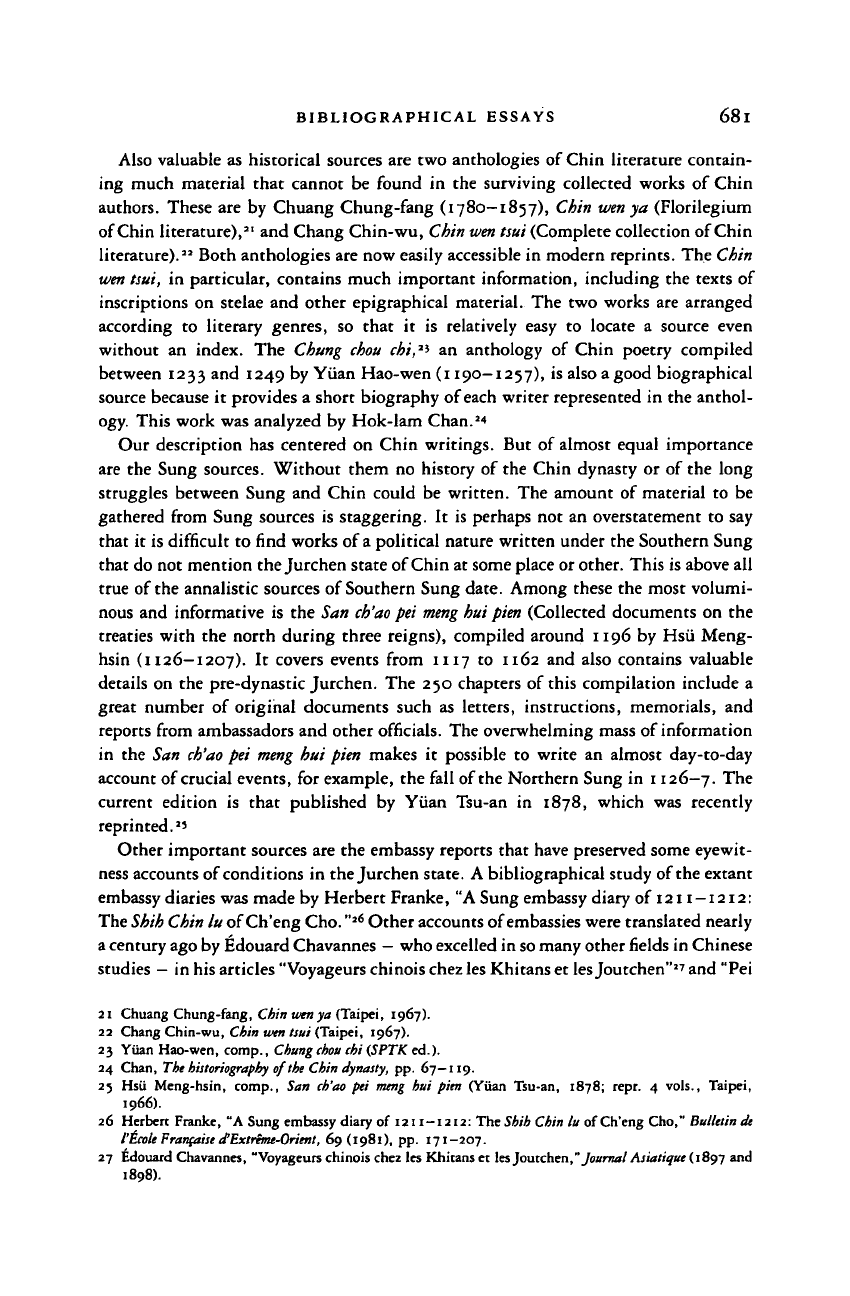
BIBLIOGRAPHICAL ESSAYS 68l
Also valuable as historical sources are two anthologies of Chin literature contain-
ing much material that cannot be found in the surviving collected works of Chin
authors. These are by Chuang Chung-fang (1780-1857), Chin
wen
ya (Florilegium
of Chin literature),
21
and Chang Chin-wu,
Chin wen tsui
(Complete collection of Chin
literature).
22
Both anthologies are now easily accessible in modern reprints. The
Chin
wen
tsui,
in particular, contains much important information, including the texts of
inscriptions on stelae and other epigraphical material. The two works are arranged
according to literary genres, so that it is relatively easy to locate a source even
without an index. The Chung
chou
chi,**
an anthology of Chin poetry compiled
between 1233 and 1249 by Yuan Hao-wen (1190—1257), is also
a
good biographical
source because it provides a short biography of each writer represented in the anthol-
ogy. This work was analyzed by Hok-lam Chan.
24
Our description has centered on Chin writings. But of almost equal importance
are the Sung sources. Without them no history of the Chin dynasty or of the long
struggles between Sung and Chin could be written. The amount of material to be
gathered from Sung sources is staggering. It is perhaps not an overstatement to say
that it is difficult to find works of
a
political nature written under the Southern Sung
that do not mention the Jurchen state of Chin at some place or other. This is above all
true of the annalistic sources of Southern Sung date. Among these the most volumi-
nous and informative is the San
ch'ao pei meng hui pien
(Collected documents on the
treaties with the north during three reigns), compiled around 1196 by Hsu Meng-
hsin (1126-1207). It covers events from 1117 to 1162 and also contains valuable
details on the pre-dynastic Jurchen. The 250 chapters of this compilation include a
great number of original documents such as letters, instructions, memorials, and
reports from ambassadors and other officials. The overwhelming mass of information
in the San
ch'ao pei meng
hui
pien
makes it possible to write an almost day-to-day
account of
crucial
events, for example, the fall of
the
Northern Sung in 1126—7. The
current edition is that published by Yuan Tsu-an in 1878, which was recently
reprinted.
2
'
Other important sources are the embassy reports that have preserved some eyewit-
ness accounts of conditions in the Jurchen state. A bibliographical study of
the
extant
embassy diaries was made by Herbert Franke, "A Sung embassy diary ofi2ii
—1212:
The
Shih Chin
lu of Ch'eng
Cho.
"*
6
Other accounts of embassies were translated nearly
a
century ago by Edouard Chavannes - who excelled in
so
many other
fields
in Chinese
studies - in his articles "Voyageurs chinois chez
les
Khitans et les Joutchen"
27
and "Pei
21 Chuang Chung-fang, Chin wen ya (Taipei, 1967).
22 Chang Chin-wu, Chin wen tsui (Taipei, 1967).
23 Yuan Hao-wen, comp., Chung
chou
chi (SPTK ed.).
24 Chan, The
historiography
of the Chin dynasty, pp. 67—119.
25 Hsu Meng-hsin, comp., San ch'ao pei meng hui pirn (Yuan Tsu-an, 1878; repr. 4 vols., Taipei,
1966).
26 Herbert Franke, "A Sung embassy diary of 1211—1212: The Shih Chin lu of Ch'eng Cho," Bulletin de
I'icole FranfaiseifExtreme-Orient, 69(1981), pp. 171-207.
27 Edouard Chavannes, "Voyageurs chinois chez les Khitans et les Joutchen," Journal Asiatique (1897 and
1898).
Cambridge Histories Online © Cambridge University Press, 2008
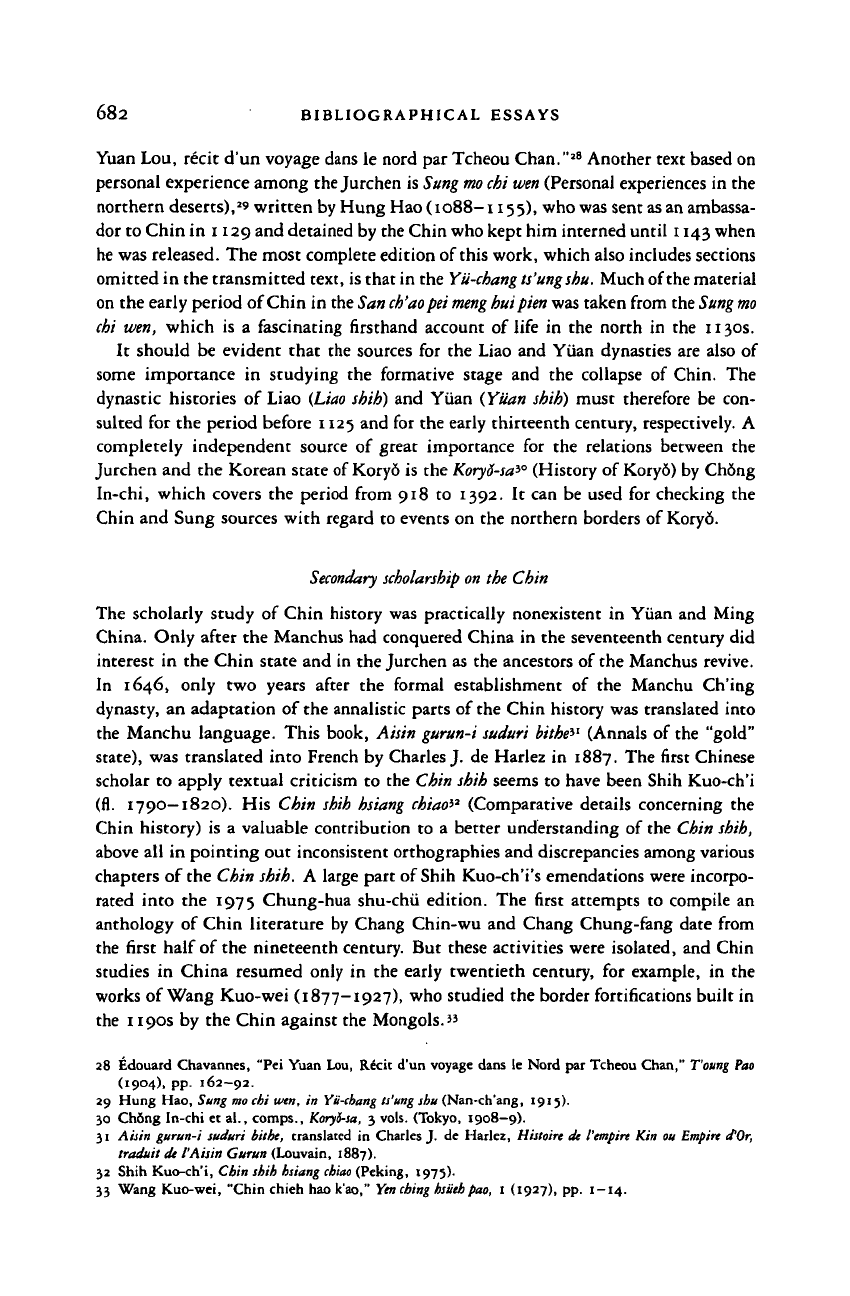
682 BIBLIOGRAPHICAL ESSAYS
Yuan Lou, recit
d'un
voyage dans
le
nord par Tcheou Chan."
28
Another text based on
personal experience among the Jurchen is Sung
mo
chi
wen
(Personal experiences
in the
northern deserts),
2
' written by Hung Hao
(1088—
1155),
who was sent as an ambassa-
dor
to
Chin
in
1129 and detained
by
the Chin who kept him interned until 1143 when
he was released. The most complete edition
of
this work, which also includes sections
omitted
in
the transmitted text, is that
in
the
Yii-chang ts'ung
shu.
Much of the material
on the early period of Chin
in
the San
ch'aopei meng
huipien was taken from the
Sung mo
chi wen, which
is a
fascinating firsthand account
of
life
in the
north
in the
1130s.
It should
be
evident that
the
sources
for the
Liao
and
Yuan dynasties
are
also
of
some importance
in
studying
the
formative stage
and the
collapse
of
Chin.
The
dynastic histories
of
Liao
(Liao
shih)
and
Yuan (Yuan shih) must therefore
be con-
sulted
for the
period before 1125
and for the
early thirteenth century, respectively.
A
completely independent source
of
great importance
for the
relations between
the
Jurchen
and the
Korean state
of
Kory6
is the
Koryd-sa>°
(History
of
Kory6)
by
Ch&ng
In-chi, which covers
the
period from
918 to 1392. It can be
used
for
checking
the
Chin
and
Sung sources with regard
to
events
on the
northern borders
of
Kory6.
Secondary scholarship
on
the
Chin
The scholarly study
of
Chin history
was
practically nonexistent
in
Yuan
and
Ming
China. Only after
the
Manchus
had
conquered China
in the
seventeenth century
did
interest
in the
Chin state
and in
the Jurchen
as the
ancestors
of
the Manchus revive.
In
1646,
only
two
years after
the
formal establishment
of the
Manchu Ch'ing
dynasty,
an
adaptation
of
the annalistic parts
of
the Chin history was translated into
the Manchu language. This book, Aisin gurun-i suduri
bithe^'
(Annals
of
the "gold"
state),
was
translated into French
by
Charles J.
de
Harlez
in
1887.
The
first Chinese
scholar
to
apply textual criticism
to the
Chin shih seems
to
have been Shih Kuo-ch'i
(fl.
1790—1820).
His
Chin shih hsiang
chiao
>2
(Comparative details concerning
the
Chin history)
is a
valuable contribution
to a
better understanding
of
the Chin shih,
above
all in
pointing
out
inconsistent orthographies and discrepancies among various
chapters
of
the Chin shih.
A
large part
of
Shih Kuo-ch'i's emendations were incorpo-
rated into
the 1975
Chung-hua shu-chii edition.
The
first attempts
to
compile
an
anthology
of
Chin literature
by
Chang Chin-wu
and
Chang Chung-fang date from
the first half
of
the nineteenth century.
But
these activities were isolated,
and
Chin
studies
in
China resumed only
in the
early twentieth century,
for
example,
in the
works
of
Wang Kuo-wei (1877-1927), who studied
the
border fortifications built
in
the 1190s
by the
Chin against
the
Mongols.'
3
a8 Edouard Chavannes, "Pei Yuan Lou, Recit d'un voyage dans le Nord par Tcheou Chan,"
Young Pao
(1904), pp. 162-92.
29
Hung
Hao,
Sung
mo
chi wen,
in
Yii-cbang ts'ung
sbu (Nan-ch'ang, 1915).
30 Ch6ng In-chi
et al.,
comps.,
KoryH-sa,
3
vols. (Tokyo, 1908—9).
31 Aisin gurun-i suduri bitbe, translated
in
Charles
J. de
Harlez, Histoire
de
Vempire
Kin
ou
Empire
d"Or,
traduit
de
I'Aisin Gurun (Louvain, 1887).
32 Shih Kuo-ch'i, Cbin shih hsiang
chiao
(Peking, 1975).
33 Wang Kuo-wei, "Chin chieh
hao
k'ao," Yencbing hsiiehpao,
1
(1927),
pp.
1
—14.
Cambridge Histories Online © Cambridge University Press, 2008
